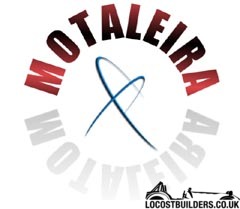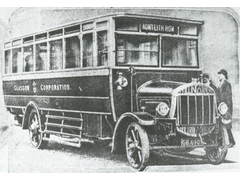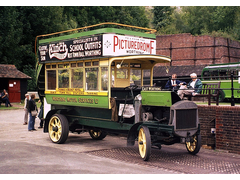Dantheman
|
| posted on 18/12/08 at 06:39 PM |

|
|
Petrol electric drive.
Just out of sheer curiosity more than anything, would it be possible to run a generator from an engine in a car to drive elecric motors to power the
wheels?
I'm thinking if you remove the clutch and gearbox and replace it with, what I believe the correct terms is, an alternator to power motors. Kinda
like a diesel electric train.
Maybe doing this would negate the need for the whole clutch/gearbox making the car drive like an automatic.
Just a hypothetical question really, enjoy taring it to pieces! 
[Edited on 18/12/08 by Dantheman]
|
|
|
|
|
nitram38
|
| posted on 18/12/08 at 06:41 PM |

|
|
Too much energy loss.

|
|
|
blakep82
|
| posted on 18/12/08 at 06:41 PM |

|
|
i don't see why it wouldn't work
________________________
IVA manual link http://www.businesslink.gov.uk/bdotg/action/detail?type=RESOURCES&itemId=1081997083
don't write OT on a new thread title, you're creating the topic, everything you write is very much ON topic!
|
|
|
coozer
|
| posted on 18/12/08 at 06:48 PM |

|
|
When the overhead tram wires started to disappear in Newcastle in the 50's the trolley buses that used these overheads were converted in such a
way. They were fitted with Gardener Douglas marine engines running a generator at fixed revs that powered the already installed electric motors.
When I worked for Northern Buses about 10 years ago there was a one at the back of the shed awaiting preservation.
[Edited on 18/12/08 by coozer]
1972 V8 Jago
1980 Z750
|
|
|
MikeR
|
| posted on 18/12/08 at 06:58 PM |

|
|
If they are such a bad idea - why do we have diesel electric trains?
I understand there will be a lot of energy loss converting the diesel to rotational energy (ie the engine bit) and the converting rotational energy to
electricity (alternator bit) and then the electricity to rotational energy (electric motor).
I'm just curious why its done & why they don't have gearboxes like trucks.
(i'm guessing the answer is either reliability or torque delivery)
|
|
|
blakep82
|
| posted on 18/12/08 at 07:09 PM |

|
|
^ thats my thinking too, if they were so bad why do we have diesel electric trains and boats? if that much energy was lost, they'd just be
diesel 
I think a small honda powered generator making 240v AC should be able to drive a good enough motor. or what about a combination of generator and
battery? ie the batteries are charged by the generator when stationary, and when moving the generator and batteries drive the motor? that should at
least reduce any wasted energy by using it to recharge batteries when possible?
as mike says, include a gearbox and you should be laughing
[Edited on 18/12/08 by blakep82]
________________________
IVA manual link http://www.businesslink.gov.uk/bdotg/action/detail?type=RESOURCES&itemId=1081997083
don't write OT on a new thread title, you're creating the topic, everything you write is very much ON topic!
|
|
|
britishtrident
|
| posted on 18/12/08 at 07:11 PM |

|
|
Tilling-Stevens were building pterol electric buses over 100 years ago.
More recently of course we have the Toyota Prius which unlike the Tilling-Stevens has battery storage, regenerative braking and moder electronics.
Below is one of the two Tilling-Stevens buses maintained by my grandfather we he started his apprenticeship with Glasgow Coporation Transport way
back when.
Interesting story is he was the only one who had the knack of hand cranking these buses and because the were petrol electric couldn't be push or
tow started so when he went on holiday they engines had to be kept running 24/7 untill he came back.
[Edited on 18/12/08 by britishtrident]
 
Rescued attachment 1924bus.jpg
|
|
|
COREdevelopments
|
| posted on 18/12/08 at 07:14 PM |

|
|
toyota prius uses a similar idea. it has an engine and two AC motors where the gearbox would be. the engine can drive the car awell as the motors,
motors then charge up the battries in the back, also uses regerative braking. similar but slightly different.
rob

|
|
|
blakep82
|
| posted on 18/12/08 at 07:15 PM |

|
|
quote:
Originally posted by britishtrident
Interesting story is he was the only one who had the knack of hand cranking these buses and because the were petrol electric couldn't be push or
tow started so when he went on holiday they engines had to be kept running 24/7 untill he came back.

________________________
IVA manual link http://www.businesslink.gov.uk/bdotg/action/detail?type=RESOURCES&itemId=1081997083
don't write OT on a new thread title, you're creating the topic, everything you write is very much ON topic!
|
|
|
britishtrident
|
| posted on 18/12/08 at 07:16 PM |

|
|
Nice 1914 Tilling-Stevens petrol electric.
 
Rescued attachment 3d.jpg
[I] “ What use our work, Bennet, if we cannot care for those we love? .”
― From BBC TV/Amazon's Ripper Street.
[/I]
|
|
|
nitram38
|
| posted on 18/12/08 at 07:21 PM |

|
|
Diesel electric trains run on either fuel source, not change diesel to mechanical then to electrical.
You get losses in petrol to mechanical plus losses from mechanical to electrical.
Your idea is flawed because you loose too much power in the conversion.

|
|
|
dinosaurjuice
|
| posted on 18/12/08 at 07:21 PM |

|
|
its used on diesel-electric trains for traction. the generators and wheel motors are a lot more efficient than one engine driving numerous bevel
drives to power 20 or more wheels.
I think some logging trucks have a hydraulic system that works on same principal.
|
|
|
UncleFista
|
| posted on 18/12/08 at 07:28 PM |

|
|
quote:
Originally posted by MikeR
If they are such a bad idea - why do we have diesel electric trains?
I understand there will be a lot of energy loss converting the diesel to rotational energy (ie the engine bit) and the converting rotational energy to
electricity (alternator bit) and then the electricity to rotational energy (electric motor).
I'm just curious why its done & why they don't have gearboxes like trucks.
(i'm guessing the answer is either reliability or torque delivery)
It's problematic getting drive to all the wheels 
Hydraulic "gearboxes" have been used on trains in the past, but were far too unreliable...
Tony Bond / UncleFista
Love is like a snowmobile, speeding across the frozen tundra.
Which suddenly flips, pinning you underneath.
At night the ice-weasels come...
|
|
|
MikeR
|
| posted on 18/12/08 at 07:48 PM |

|
|
quote:
Originally posted by nitram38
Diesel electric trains run on either fuel source, not change diesel to mechanical then to electrical.
You get losses in petrol to mechanical plus losses from mechanical to electrical.
Your idea is flawed because you loose too much power in the conversion.
If Wikipedia is correct, this isn't quite true. BR did use duel mode trains so that they didn't have to electrify the shunting yards.
BUT - diesel electric engines - as used to shift cargo and passengers up things like the west coast main line are actually diesel generators powering
electric motors.
wiki link - http://en.wikipedia.org/wiki/Diesel-electric_locomotive#Diesel-electric
|
|
|
tomblyth
|
| posted on 18/12/08 at 08:00 PM |

|
|
the honda on this weeks top get has an engine producing electric to run electric motors in the wheel!
see link
electric car
|
|
|
nitram38
|
| posted on 18/12/08 at 08:02 PM |

|
|
OK I may be wrong, but however you look at it, running an engine to the wheels without converting to electricity first will use less fuel.

|
|
|
MikeRJ
|
| posted on 18/12/08 at 08:02 PM |

|
|
quote:
Originally posted by nitram38
Diesel electric trains run on either fuel source, not change diesel to mechanical then to electrical.
You get losses in petrol to mechanical plus losses from mechanical to electrical.
Your idea is flawed because you loose too much power in the conversion.
You are thinking of an "electro-diesel" locomotive which can run on either source, but I don't think there are very many of them on
the UK rail network.
A Diesel-electric locomotive powers a generator with the diesel engine, which then powers one or more electric motors. They have been around since
the mid 1920's.
The conversion loss isn't that bad, large alternators and motors (especially modern electronically commutated ones) are very efficient. The big
advantage of this system is that an electric motor provides it greatest torque at zero RPM, i.e. you get the most torque right when you actually need
it, pulling away from a stop. You get step-less control of speed, no jerky gearchanges, and since motors and alternators have only one moving part,
you gain reliability over a geared transmission. Also by mounting the traction motors directly onto the bogies, you don't have to worry about a
complex transmission system, you just need some flexible high current cables.
[Edited on 18/12/08 by MikeRJ]
|
|
|
smart51
|
| posted on 18/12/08 at 08:31 PM |

|
|
The ideal way to drive a car today would be petrol electric or diesel electric.
Typically, a car in the UK has about 100 BHP. Thats 100 BHP at 6000 RPM. Most cars don't go above 3000 RPM or so during their lives. Thats
about 60 BHP. Much of the time they cruise around at 2000 RPM at about 1/2 throttle, or about 15 BHP.
What you need is a 15 BHP generator and a small set of batteries with 100 BHP worth of electic motors in the wheels. When accelerating, the batteries
and generator provide all the power you need. When criuising, the generator is enough to keep you going. At lower speeds, the generator tops the
battery up as well as feeding the motors. Regenerative braking and the generator running when the car is stationary tops up the battery again.
You can design your generator's engine to run at 1 speed and optimise everything for that one speed. The conversion losses are more than made
up for in engine efficiency which can be close to the theoretical maximum. Plus, when fuel cells are finally ready, you can just swap your old
generator out for a new one.
In wheel motors are the same weight as current hubs, uprights and brakes and replace all these functions (see pml flight link's web page).
Provided your generator and batteries are the same weight as your old engine, gearbox, diff and drive shafts, you've not gained any weight.
|
|
|
Dantheman
|
| posted on 18/12/08 at 08:33 PM |

|
|
I think the point I was getting at was it would get rid of the clutch and gearbox which seems to be the weak link in high performance cars.
Imagine it being used in something like a Veyron. It couldnt have been easy trying to transmit 1000 horsepower through a clutch and delicate gearbox,
then to all four wheels.
Replace the transmission with an alternator and give each axle its own motor. I'm sure there would be some energy loss but I think it could be
kept to a minimum.
|
|
|
smart51
|
| posted on 18/12/08 at 08:33 PM |

|
|
quote:
Originally posted by MikeRJ
quote:
Originally posted by nitram38
Diesel electric trains run on either fuel source, not change diesel to mechanical then to electrical.
You get losses in petrol to mechanical plus losses from mechanical to electrical.
Your idea is flawed because you loose too much power in the conversion.
You are thinking of an "electro-diesel" locomotive which can run on either source, but I don't think there are very many of them on
the UK rail network.
A Diesel-electric locomotive powers a generator with the diesel engine, which then powers one or more electric motors. They have been around since
the mid 1920's.
Can you imagine the size of the clutch you'd need if they drove the wheels from the engine?
|
|
|
MikeRJ
|
| posted on 18/12/08 at 08:54 PM |

|
|
quote:
Originally posted by smart51
Can you imagine the size of the clutch you'd need if they drove the wheels from the engine?
They would use a fluid coupling (e.g. a torque converter) rather than a friction clutch.
I've been on a small shuttle train which had a diesel engine with a mechanical transmission. You could hear the driver changing gears and there
was a big lurch every time so anyone standing up fell over 
|
|
|
blakep82
|
| posted on 18/12/08 at 09:00 PM |

|
|
i like trains 
hate being a passenger on them though...
________________________
IVA manual link http://www.businesslink.gov.uk/bdotg/action/detail?type=RESOURCES&itemId=1081997083
don't write OT on a new thread title, you're creating the topic, everything you write is very much ON topic!
|
|
|
coozer
|
| posted on 18/12/08 at 09:04 PM |

|
|
Can anyone tell me why the diesel- electro train is so successful and buses had it 50 or more years ago why we don't have cars the same.
Trams typically had 2 x 60hp motors so imagine the Tesla (see it go on Top Gear??) dumping 75% of its batteries and having a small 50hp bio/corn oil
engine turning an alternator providing power to the main motor and charging the batteries.
Anyone fancy giving it a go?? I would love a Tesla as it is!
1972 V8 Jago
1980 Z750
|
|
|
MikeR
|
| posted on 18/12/08 at 11:35 PM |

|
|
What are the weights we're looking at here.
15hp engine and fuel tank,
15hp alternator
2x 60hp motors (i'm thinking performance here, we could do 1x60hp motor for a city car, heck old minis used to have 45hp).
large splodge of battery.
|
|
|
trogdor
|
| posted on 19/12/08 at 02:17 PM |

|
|
if i was going to do this i wouldn't use a engine to power an electric motor i would use a turbine! I would think it would be more efficent and
is ideal for a turbine (steady rpm's)
plus you can use kerosene etc to run it on.
|
|
|













